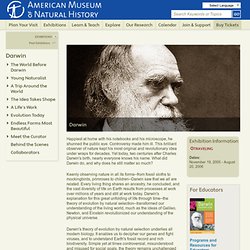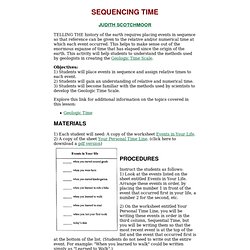

The Evolution of Flight in Birds. Was Darwin Wrong ? Darwin. Happiest at home with his notebooks and his microscope, he shunned the public eye.

Controversy made him ill. This brilliant observer of nature kept his most original and revolutionary idea under wraps for decades. Yet today, two centuries after Charles Darwin's birth, nearly everyone knows his name. What did Darwin do, and why does he still matter so much? Keenly observing nature in all its forms--from fossil sloths to mockingbirds, primroses to children--Darwin saw that we all are related. Darwin's theory of evolution by natural selection underlies all modern biology. Charles Darwin looked closely at life.
With persistence and passion, Darwin set out to find answers. The American Museum of Natural History gratefully acknowledges The Howard Phipps Foundation for its leadership support. Evolution and the Fossil Record by John Pojeta, Jr. and Dale A. Springer. Darwin's Revolutionary Theory (Previous Page || Next Page) Charles Darwin used information from several disciplines in developing his theory of evolution.

He was particularly impressed by the amount of variation that occurs within living species, especially in domestic animals, and he spent a great deal of time studying breeding programs. Even in Darwin’s day, the human effort in breeding variants of domestic animals had resulted in many breeds of dogs, cats, horses, sheep, and cattle. As an example, consider the tremendous variation in domestic dogs. The Chihuahua and the Saint Bernard are about as different in size, shape, hair length, and other features as one could imagine; yet both breeds are domestic dogs with the scientific name Canis familiaris. Evolution Ep1: Darwin's Dangerous Idea (1/11) Upper Jawbone of Mastodon. Endangered Relationships: Lesson Overview. (Click here for a printer-friendly version of this lesson) TOPIC/SUBJECT MATTER: Life Science/Environmental Science TIME ALLOTMENT: 1-2 45-minute class periods This lesson uses video segments from the NATURE film “Crash: A Tale of Two Species” to explore the interrelationship between the horseshoe crab and a small migratory bird called the red knot.

Both species are in decline, and the red knot’s future, in particular, depends on the horseshoe crab making a comeback in the waters of the Delaware Bay. Students will first be introduced to the horseshoe crab via a video segment, learning that the species’ longevity (350 million years) makes the horseshoe crab a “living fossil,” an anomaly in terms of the Earth’s species. As a culminating activity, students will use an interactive online map to research endangered species in the region of the United States where they live. Video NATURE: Crash: A Tale of Two Species (selected segments): Clip 1: “The Living Fossil” Web sites Standards: Materials. Adventures at Dry Creek. Whale Fossil Found in Kitchen Counter. May 5, 2009—After a factory had found a 40-million-year-old whale fossil in a limestone kitchen counter, researchers investigated the stone's fossil-packed Egyptian quarry, which could shed light on the origins of African wildlife.

Video by Public Television's Wild Chronicles, from National Geographic Mission Programs Unedited Transcription. Navigating Life Has a History, Level 2. Life Preservers Teacher Site. SEQUENCING TIME. TELLING THE history of the earth requires placing events in sequence so that reference can be given to the relative and/or numerical time at which each event occurred.

This helps to make sense out of the enormous expanse of time that has elapsed since the origin of the earth. This activity will help students to understand the methods used by geologists in creating the Geologic Time Scale. Objectives: 1) Students will place events in sequence and assign relative times to each event. 2) Students will gain an understanding of relative and numerical time. 3) Students will become familiar with the methods used by scientists to develop the Geologic Time Scale. Explore this link for additional information on the topics covered in this lesson: Understanding Evolution. The bacteria that changed the world - May, 2017 The make-up of Earth's atmosphere, once the domain of Earth science textbooks, has become an increasingly "hot" news topic in recent decades, as we struggle to curb global warming by limiting the carbon dioxide that human activity produces.

While the changes that humanity has wrought on the planet are dramatic, this isn’t the first time that one species has changed Earth’s atmosphere. Three billion years ago, there was no free oxygen in the atmosphere at all. Life was anaerobic, meaning that it did not need oxygen to live and grow. That all changed due to the evolution of Cyanobacteria, a group of single-celled, blue-green bacteria. Evolution.